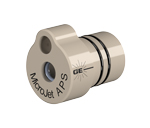
 |
CHINESE |  |
ENGLISH |  |
FRENCH |  |
GERMAN |  |
ITALIAN |  |
JAPANESE |  |
RUSSIAN |  |
SPANISH |  |
| mail this page to a colleague | |||||||||||||||||

|
|||||||||||||||||
|
| HOME | PRODUCTS | PRODUCT CARE | SEARCH | SHOPPING CART | NEWS | ABOUT US | DISTRIBUTORS | CONTACT US |
Originally designed as a highly efficient single-cell sample introduction system, Glass Expansion's HE-SIS has been redesigned to provide superior performance across a wide variety of applications, including single-cell, single particle, nanoparticle, and low-volume sample studies, with up to 95% transport efficiency.


Conventional ICP-MS spray chambers have low transport efficiencies (typically < 5% TE) that filter out larger droplets ( > 5µm) from the nebulizer aerosol. The Glass Expansion HE-SIS features three critical components to overcome this significant sample transport deficiency.






In a comparison of the average sensitivity, Glass Expansion's HE-SIS provided a factor of 2 to 3 increase compared to another commercially available single-cell or laminar flow sample introduction system (BrandX). The sensitivity ratio of the HE-SIS to BrandX was averaged for 16 masses, ranging low to high at a nebulizer sample flow rate ranging from 4 to 100 uL/min.
This increase in sensitivity is indicative of the high quality design of the Glass Expansion HE-SIS and patent pending MicroJet which greatly improves the transport efficiency compared to other commercially available systems.


With every sample introduction system, the operating conditions should be optimized in order to achieve the best performance possible. In our HE-SIS Webinar we highlight the optimization of the HE-SIS nebulizer and MicroJet.
This webinar is a great introduction to the HE-SIS and can be used as a tutorial to achieve optimum transport efficiency and understand each operating parameter of the HE-SIS and its effect on overall performance.
| Part Number | Description |
|---|---|
| KT-1155 | HE-SIS for Agilent® ICP-MS |
| KT-1172 | HE-SIS for TOFWERK icpTOF |
| KT-1172 | HE-SIS for Thermo® Q, RQ, TQ ICP-MS |
| KT-1172 | HE-SIS for Thermo® Neoma MC-ICP-MS |
| KT-1184 | HE-SIS for PerkinElmer® NexION 1000, 1100, 2000, 2200, 5000 |
| KT-1204 | HE-SIS for PerkinElmer® NexION 300, 350 |
| KT-1205 | HE-SIS for Nu ATTOM |
| KT-1213 | HE-SIS for Thermo® X Series |
| KT-1215 | HE-SIS for Thermo® Neptune, Element |
| KT-1219 | HE-SIS for Nu Vitesse |
(In reference to the High Efficiency Sample Introduction System) We have been using your system since we have got best transport efficiencies when compared to other ones in the market. Generally, we obtain something like 70-80% in bacteria and yeast and lower (50-60%) in eukaryotic cells and NPs.
University laboratory – Spain
We have been using the Glass Expansion High Efficiency Sample Introduction System in several studies including cells and Au NPs. Regarding the Au NPs, depending on operating conditions, transport efficiencies ranging between 60 and 95% were achieved.
ICP manufacturer - Europe
We tried the configuration you provided us, and the high efficiency sample introduction worked perfectly. We are tremendously grateful for your help.
University laboratory – Spain